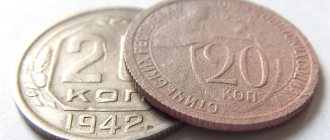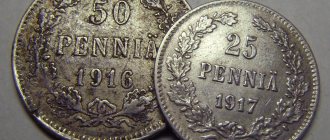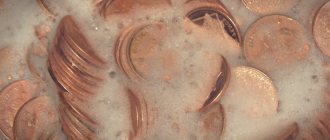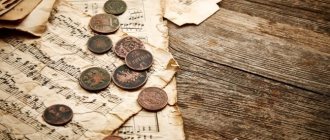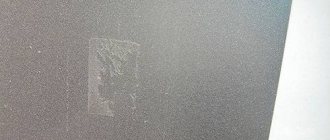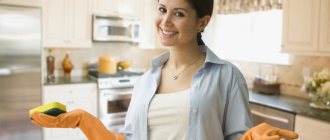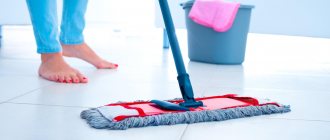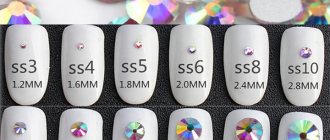An alloy of aluminum and bronze was widely used during the Soviet era to make coins. Today, many specimens have ended up in private collections of numismatists. Periodically, such products require cleaning, and for this process to be effective and safe, it is necessary to have information about the methods and methods of cleaning aluminum bronze coins.
Common problems include: deposits of dirt, dust, traces of oxidation, and the formation of a grayish film on the surface of the coin.
Simple and gentle methods
Soap solution
An alloy of aluminum and bronze can be placed in a thick soap solution for a long time. If there is no serious contamination on the coin, then no further manipulations will be required after removing it from the container with soapy water.
Lemon acid
More complex cases can be cleaned using citric acid, which is diluted with water in a ratio of 1:2 (one part acid and two parts water). The coin placed in the solution is regularly turned over to avoid damage to the coating.
Coca-Cola (or equivalent)
You can try the Coca-Cola cleaning method. The coin is placed in soda for a week; after the period has expired, it is washed under running water to remove remaining dirt particles.
Vinegar 9%
Another simple and affordable cleaning method is to use table vinegar diluted with water. Take two tablespoons of vinegar per glass of water. The coin should be dipped into the resulting essence for three minutes, after which you can wipe it with soda powder.
How to clean an old coin
To ensure that the collectible object does not lose its value, it cannot be cleaned until it shines, as this will negatively affect the preservation of the relief. Rough mechanical or chemical cleaning is also unacceptable. Since old coins can be very fragile, in most cases they are either not cleaned at all or are cleaned using special gentle products. It is also acceptable to use electrolysis.
Having studied various methods of cleaning coins and choosing the optimal one, you need to maintain the accuracy of each step.
Cleaning a coin is a delicate and responsible process for which you need to carefully prepare. However, if all the rules are followed, you can get a neat and restored collectible object.
Aggressive cleaning methods
Brush and soda
For those who are not afraid to take a risk and resort to a mechanical method of getting rid of dirt, it is recommended to use a suede brush. For severe stains, you can take crushed baking soda powder, apply it to a coin and rub it with a brush.
This method may cause scratches on the surface. If the item previously had microcracks, then the stuck particles of soda will significantly reduce the value of the collectible item - it’s worth taking this into account.
Household chemicals
A bath cleaner can be used to get rid of stubborn dirt, but it must first be diluted in water and only then wipe the surface of the coin with the composition, and then rinse under running water. You can dip a coin in solutions of household chemicals for two minutes, no more.
Use of aggressive chemistry
The most effective method for cleaning bronze-aluminum coins, however, it is also the most dangerous.
- Firstly, such products cannot be used in concentrated form.
- Secondly, not every collector knows what proportions and time of application should be observed.
- Thirdly, if you handle aggressive chemicals carelessly, you can get a burn to the skin and mucous membrane of the nose and eyes.
Another disadvantage is the difficulty in finding the necessary funds. Not all chemicals are commercially available.
Cleaning coins using electrolysis
This method will appeal to fans of science experiments. The coin is attached to a negative charge, and the positive charge is connected to a metal object. The system is placed in a saline solution and when a current passes through the coin, the cleaning mechanism is started accordingly.
When using this method, do not forget about safety rules.
Cleaning bronze items – is it really necessary?
Many people do not know whether it is necessary to clean bronze products at all, be they coins or any figurines or dishes. It is important to take into account that the condition of the products depends on their age - many coins cast from bronze are covered with a thin film, which can be brown or green. If the products are characterized by an even structure, there are no corrosion defects or visible damage, there is no need to clean the coins - such a film acts as a natural protection.
If you start cleaning coins, you will damage the natural protection, which can completely ruin the appearance of the coins and, naturally, reduce their price. If you want to tidy up items covered with film, just gently wipe the coins with soapy water and rinse in bottled water - this will help rid bronze moments and figurines of grease stains, a layer of dust, and fingerprints.
Important: coins should not be rubbed forcefully, especially if the items are too old. This may cause the pattern to change.
But if you decide that your product collection requires a makeover, we will tell you how and with what to clean bronze products and aluminum bronze.
What is prohibited in cleaning aluminum bronze coins?
There are several prohibited cleaning products that are sure to harm the rarity:
- kaol;
- brasso;
- iodine.
There are precedents when it is impossible to completely clean a coin from contamination, in which case it is better to leave everything as is and not take the unjustified risk of damaging the exhibit.
Among other tips for choosing a cleaning method, they recommend: if the coin is heavily soiled, if the coin costs more than one hundred dollars, stop doing it yourself and entrust the matter to a professional.
Actions after cleaning
A shine on coins after cleaning is not a good sign. Of course, the fact that you cleaned the coin is good, but it remains an antique piece, so it should look the part. Collectors will also not want to purchase an antique coin that is too clean and shiny.
In addition, you need to protect the specimen from external influences. To do this, it is necessary to create a patina artificially. The difference between a coin before cleaning and the final version is that the patina, created quickly and artificially, will be beautiful and uniform. It will only give the appearance of antiquity without spoiling the appearance of the coin. There are two ways to create a weak oxide layer on aluminum:
- Place the coin in the sun so that the sun's rays hit it. This option is longer, but natural.
- Lubricate the specimen with a thin layer of iodine. The procedure is faster than the first method.
Cleaning coins from contamination is not so difficult. The methods are suitable for people with different income levels. To avoid doing this too often, it is enough to monitor the condition of the coins and wipe them periodically.
Is it acceptable to clean bimetallic coins at home?
Most collectors do a great job cleaning coins without outside help. Having simple means at your disposal, you can get rid of stubborn dirt almost free of charge.
The main conditions are the proper selection of cleaning products and compliance with safety precautions when working with acids and abrasives.
You should definitely figure out which cleaning method is suitable for a particular metal or alloy. If we are talking about a bimetallic coin, where different metals were used in production, then choose a cleaning agent suitable for both materials.
Conclusion: Bronze-aluminum coins can be successfully cleaned at home.
Cleaning coins with special means
Ready-made products allow you to clean coins effectively and safely. However, you need to choose them carefully so that the collectible item does not lose its value.
The algorithm for cleaning coins made of copper and silver is characterized by the same simplicity and accessibility as for similar copper products.
The most popular compositions are:
- Paste "Asidol-M". It has an unlimited shelf life, consists of surfactants and fine abrasive. Suitable for cleaning all types of coins (except especially valuable ones), as well as other metal products.
- Pasta "USSR". Contains nanodispersed abrasive, sodium bicarbonate and sodium potassium tartrate. Has a mild odor. Suitable for products made of brass, bronze and copper.
- Tool "Modern Russia". Consists of nanodispersed abrasive and organic acids. Suitable for cleaning bimetallic and plated coins.
- Cleaner for copper dug coins. Contains anti-corrosion components. The active substance is an oxidizing agent made from higher oxides of transition metals, which is why working with the product must be done with special protective gloves.
- Trilon B powder. A budget option that is effective in cleaning dug coins that are minted from a single metal. To increase efficiency, specimens are placed on edge. The product causes irritation to mucous membranes, so safety glasses will be required for operation.
- Coin passivation product from Shine Coins. The paste contains petroleum oil and corrosion inhibitors. Used to protect coins from corrosion and tarnishing.
- Nano patina product. Made from acid and copper sulfate. Suitable for cleaning any metals.
- Mirror surface restorer from Shine Coins. This is a powerful solution made on the basis of an acid and a complexing agent. Used to remove fingerprints and patina from the surface of silver coins.
Cleans patina and removes fingerprints.
Cleaning Zinc Samples
It is very difficult to tidy up zinc coins. The metal reacts actively with strong acids, but zinc salts react weakly with weak acids. Thus, when selecting a drug, it is important to maintain a middle ground.
More often than others, hydrochloric acid is recommended for cleaning zinc coins. A 10% concentration can dissolve a coin in a few minutes, so use a solution with no more than 1% of the active substance. In order not to miss the moment when the acid corrodes not the oxides, but the coin itself, you need to constantly monitor the reaction and check the result every 3-5 seconds.
The acid should be washed off under running water, and not in a container, because in stagnant water the reaction will continue.
The special universal liquid Leuchtturm can handle the care of zinc products better than others. Soaking the coin for 15 minutes is enough.
The collector will have to come to terms with the fact that after cleaning, zinc pennies still darken when exposed to air.
Goi paste
Due to the fact that zinc coins are difficult to clean using chemical methods, you can often find advice to use mechanical treatment, incl. using GOI paste.
This chromium oxide paste was developed in the 1930s by the State Optical Institute (hence the name) for the care of optical lenses. Available in three varieties: coarse, medium and fine (polishing).
The effect of the product can be compared to cleaning with soda, but a professional paste removes dirt many times faster. This method is absolutely contraindicated for processing coins with small relief, because polishing it will damage or completely destroy it.
Removing plaque, rust, bronze
The cleaning method depends not only on the material of the coin, but also on the nature of its contamination:
- Trilon B and various acids (hydrochloric, sulfuric, formic) help against rust. These are very active, so you need to watch the reaction. You can neutralize the acid after cleaning with soap or soda solution.
- The reddish tint of plaque (from cherry to brown) is copper oxide; it is removed with a solution of ammonium carbonate or ammonia.
- A yellow-white or yellow coating indicates the presence of lead in the alloy or the long-term interaction of the coin with lead. Acetic acid will help here.
- White plaque is caused by zinc. You can deal with it by soaking the coin in distilled water for 2-3 days and cleaning it with a brush.
- Black deposits are removed by ammonia.
- Bronzewort (bronze disease) appears in the form of pale green grains. It is almost impossible to clean such plaque on your own. Restorers use a humidification chamber for this.
